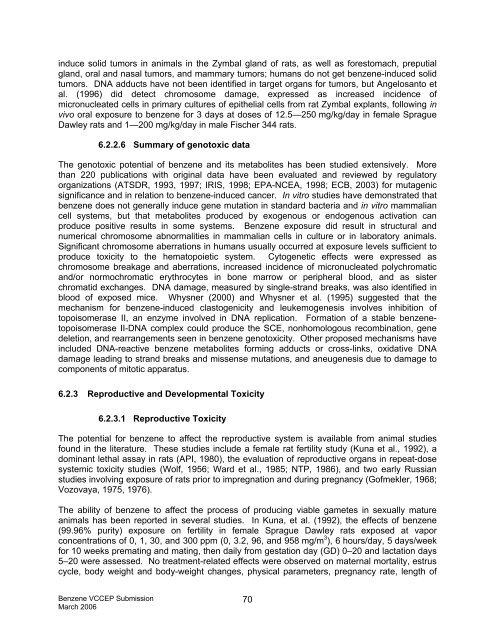(VCCEP) Tier 1 Pilot Submission for BENZENE - Tera
(VCCEP) Tier 1 Pilot Submission for BENZENE - Tera
(VCCEP) Tier 1 Pilot Submission for BENZENE - Tera
Create successful ePaper yourself
Turn your PDF publications into a flip-book with our unique Google optimized e-Paper software.
induce solid tumors in animals in the Zymbal gland of rats, as well as <strong>for</strong>estomach, preputial<br />
gland, oral and nasal tumors, and mammary tumors; humans do not get benzene-induced solid<br />
tumors. DNA adducts have not been identified in target organs <strong>for</strong> tumors, but Angelosanto et<br />
al. (1996) did detect chromosome damage, expressed as increased incidence of<br />
micronucleated cells in primary cultures of epithelial cells from rat Zymbal explants, following in<br />
vivo oral exposure to benzene <strong>for</strong> 3 days at doses of 12.5—250 mg/kg/day in female Sprague<br />
Dawley rats and 1—200 mg/kg/day in male Fischer 344 rats.<br />
6.2.2.6 Summary of genotoxic data<br />
The genotoxic potential of benzene and its metabolites has been studied extensively. More<br />
than 220 publications with original data have been evaluated and reviewed by regulatory<br />
organizations (ATSDR, 1993, 1997; IRIS, 1998; EPA-NCEA, 1998; ECB, 2003) <strong>for</strong> mutagenic<br />
significance and in relation to benzene-induced cancer. In vitro studies have demonstrated that<br />
benzene does not generally induce gene mutation in standard bacteria and in vitro mammalian<br />
cell systems, but that metabolites produced by exogenous or endogenous activation can<br />
produce positive results in some systems. Benzene exposure did result in structural and<br />
numerical chromosome abnormalities in mammalian cells in culture or in laboratory animals.<br />
Significant chromosome aberrations in humans usually occurred at exposure levels sufficient to<br />
produce toxicity to the hematopoietic system. Cytogenetic effects were expressed as<br />
chromosome breakage and aberrations, increased incidence of micronucleated polychromatic<br />
and/or normochromatic erythrocytes in bone marrow or peripheral blood, and as sister<br />
chromatid exchanges. DNA damage, measured by single-strand breaks, was also identified in<br />
blood of exposed mice. Whysner (2000) and Whysner et al. (1995) suggested that the<br />
mechanism <strong>for</strong> benzene-induced clastogenicity and leukemogenesis involves inhibition of<br />
topoisomerase II, an enzyme involved in DNA replication. Formation of a stable benzenetopoisomerase<br />
II-DNA complex could produce the SCE, nonhomologous recombination, gene<br />
deletion, and rearrangements seen in benzene genotoxicity. Other proposed mechanisms have<br />
included DNA-reactive benzene metabolites <strong>for</strong>ming adducts or cross-links, oxidative DNA<br />
damage leading to strand breaks and missense mutations, and aneugenesis due to damage to<br />
components of mitotic apparatus.<br />
6.2.3 Reproductive and Developmental Toxicity<br />
6.2.3.1 Reproductive Toxicity<br />
The potential <strong>for</strong> benzene to affect the reproductive system is available from animal studies<br />
found in the literature. These studies include a female rat fertility study (Kuna et al., 1992), a<br />
dominant lethal assay in rats (API, 1980), the evaluation of reproductive organs in repeat-dose<br />
systemic toxicity studies (Wolf, 1956; Ward et al., 1985; NTP, 1986), and two early Russian<br />
studies involving exposure of rats prior to impregnation and during pregnancy (Gofmekler, 1968;<br />
Vozovaya, 1975, 1976).<br />
The ability of benzene to affect the process of producing viable gametes in sexually mature<br />
animals has been reported in several studies. In Kuna, et al. (1992), the effects of benzene<br />
(99.96% purity) exposure on fertility in female Sprague Dawley rats exposed at vapor<br />
concentrations of 0, 1, 30, and 300 ppm (0, 3.2, 96, and 958 mg/m 3 ), 6 hours/day, 5 days/week<br />
<strong>for</strong> 10 weeks premating and mating, then daily from gestation day (GD) 0–20 and lactation days<br />
5–20 were assessed. No treatment-related effects were observed on maternal mortality, estrus<br />
cycle, body weight and body-weight changes, physical parameters, pregnancy rate, length of<br />
Benzene <strong>VCCEP</strong> <strong>Submission</strong><br />
March 2006<br />
70





